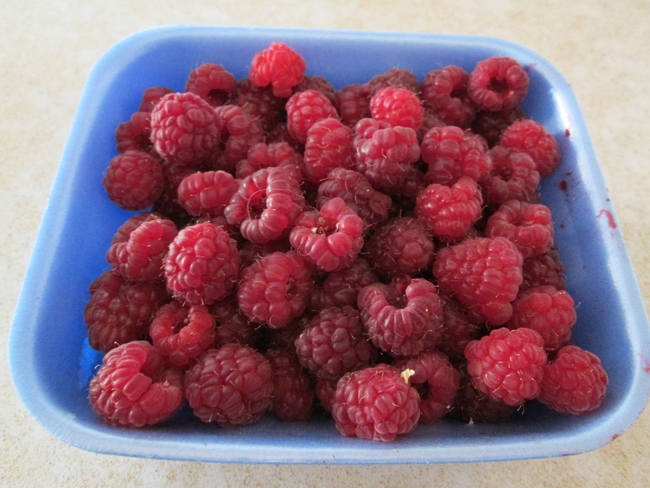When we first moved to the Owens Valley 12 years ago we inherited a well-stocked garden, one feature of which was a border of raspberries. Sadly, I forgot to ask the previous homeowner which variety they were. I was amazed to think that one could grow these in a place which has such hot summers, since I had always been taught that raspberries grow in much more equable climates such as the Pacific Northwest.
However, these plants did not let me down and produced a crop on the one-year-old stems (floricanes) in late May/early June followed by a smaller crop in fall on the current season's growth (primocanes) in October. They are growing in front of an east-facing 6' high wooden fence so they get morning and early afternoon sun. They are drip irrigated with two parallel lines about 16 inches apart with in-line emitters every 12 inches.
The canes are sturdy, self-supporting, slightly spiny, 3'-4' high and do not need to be staked. The berries are not particularly large but are firm and hold up well in the freezer. The flavor is good but not exceptional.
However, in recent years the fall crop has failed. Although flowers appear in September and are worked enthusiastically by bees the young berries have been destroyed by an early frost (although after the damage was done the weather warmed up considerably for several days afterwards).
Then I made my big mistake! I came across a variety called 'Joan J' in a catalog and it was described as the earliest of the fall fruiting varieties. That would surely miss the frost and furthermore the stems are spineless, berries large and with very good flavor. Just what I needed – or so I thought.
I cleared some of my old canes and replaced as much of the soil as I could and planted in the spring. They grew extremely vigorously and before long I was hammering in stakes and stringing wires in order to keep up with them, but even so some of the canes did not get tied in and the lush green growth soon flopped over.
I was excited to see the first flowers appearing in late June—huge panicles of blooms on the tips of the new stems. And that was when the problem began! I had lost a tree that had provided some shade to the canes so the plants were getting too much sun right in the middle of summer when our temperatures were soaring well into the 100°F range. As a result the berries were either drying into a pippy mess or cooking in the hot sun which attracted a goodly number of green stink bugs. I had very few berries that were suitable for harvest but they did have a strong and wonderful flavor. Many of the tips had flopped over the supporting wire so that the stems were bent double and of course this resulted in the berries dying.
Another problem was that these plants did not stay put neatly in the row where they were planted and have spread themselves into adjoining crops of strawberries and rhubarb.
Rethinking the Problem
After a few disappointing seasons my choices appear to be:
- To abandon this variety altogether and choose a variety that will ripen in September
- To try and rig up some sort of shade cloth which will not take off in the wind
- Replant them in a more open area where perhaps they would get less reflected heat from the fence, but I would have to sacrifice some other crop to do that
- Concentrate on growing floricane fruiting varieties which give a single good crop in June before one gets busy dealing with tree fruits
Any suggestions that I haven't thought of? Feel free to leave your comments below.
To learn more about raising raspberries in our area see this link: https://ucanr.edu/sites/newinyomonomg/Eastern_Sierra_Gardening/Fruits/Raspberries/
